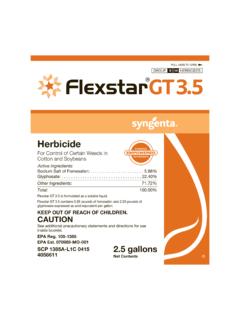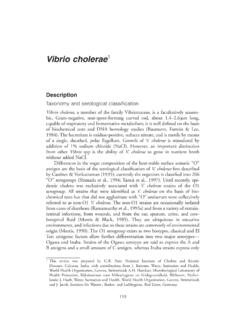Transcription of Whitefly-transmitted viruses in vegetable crops
1 Department of Employment, Economic Development and Innovation Agri-Science Queensland Whitefly-transmitted viruses in vegetable crops Integrated virus disease management Adult silverleaf whitefly Eggs and adult silverleaf whitefly The whitefly is a small sucking insect related to aphids, Although Australia is fortunate to be free of many of leafhoppers and mealybugs. these whitefly -borne viruses , several viruses do occur and result in important crop losses. The nature and Two species of whitefly are important pests in vegetable management of these virus diseases and their whitefly crops in Australia: vectors is outlined below.
2 The greenhouse whitefly (Trialeurodes vaporariorum). Bemisia tabaci exists as a number of strains or biotypes the silverleaf whitefly (Bemisia tabaci). which are distinguished by host crops , responses to whitefly prefer the undersides of young leaves and have insecticides and DNA fingerprints'. the capacity for rapid reproduction when conditions are The silverleaf whitefly or B biotype arrived in Australia favourable. When leaves are disturbed in infested crops , in the early 1990s and is now abundant in vegetable clouds of white flying insects indicate their presence.
3 And field cropping areas in northern Australia. It has also been found in Perth and Carnarvon in Western Both species of whitefly have a wide range of host Australia, and the north coast, Sydney basin, Narrabri plants among crops , weed species and ornamental and Riverina areas of New South Wales. plants. They damage plants by sucking the plant's sap causing reduced growth, stunting and yield reduction. Biotype B is a serious pest in many vegetables Honeydew secretions from whitefly can result in the including cucurbits, capsicums, tomato, eggplant, development of sooty mould on produce.
4 The silverleaf brassicas, lettuce, sweetpotato and beans. The insect whitefly injects toxic saliva while feeding, causing has a high reproduction rate and a short generation silvering of leaves in cucurbits and irregular ripening time. It also has the ability to quickly develop and blotching in tomato fruit. resistance to insecticides. The whitefly is also an important vector or carrier of Trialeurodes vaporariorum, the greenhouse whitefly viruses which result in enormous economic losses in has been present in Australia for many years. It favours temperate environments and is a common pest in vegetable , grain and fibre crops worldwide.
5 Greenhouses and other protected cropping situations. Symptoms of Tomato yellow leaf curl virus on tomato Cucumber yellows (Beet pseudoyellows virus). whitefly life cycle Begomoviruses The life cycles of the silverleaf whitefly and This large group of viruses are members of the greenhouse whitefly are similar, although the two Geminivirus family. The begomoviruses, named after species prefer different temperature ranges for Bean golden mosaic virus, are transmitted only by optimal development. The silverleaf whitefly prefers the silverleaf whitefly and cause major crop losses in temperatures of 25 C to 30 C for development and vegetable , grain legume and cotton crops throughout rapid generation time while the greenhouse whitefly tropical, subtropical and Mediterranean regions.
6 Prefers temperatures of 20 C to 25 C. New begomovirus virus species continue to be whitefly eggs are attached to the underside of the leaf found worldwide and these often result from genetic surface, usually younger leaves. Eggs hatch in eight to recombination between viruses present in plants as 10 days. There are four immature or nymphal stages. multiple infections. Crawlers or first instar nymphs crawl a short distance Fortunately, few begomovirus occur in Australia. before settling to feed on plant tissue. Second Tomato yellow leaf curl virus (TYLCV) is a recent and third instar nymphs are stationary and remain incursion and was found in south east Queensland in attached to the leaf surface where they feed until 2006 and now causes serious crop losses throughout developing into the fourth and final nymphal stage.
7 The region, particularly at Bundaberg. In 2011 the virus These fourth instar nymphs stop feeding, pupate and was found at Mareeba on the Atherton tableland. emerge from the pupal case as fully developed adults. Symptoms: Affected plants grow slowly and become The active adult whitefly is largely responsible for stunted. Leaflets are rolled upwards and inwards virus spread from plant to plant. and develop interveinal chlorosis. Leaves are often The silverleaf whitefly takes 18 to 28 days from egg to bent downwards and are stiff. Yield and fruit quality adult in warm weather and 30 to 48 days in winter.
8 Is reduced. At 22 C the greenhouse whitefly completes a life cycle in about 28 days. 'The whitefly acquires TYLCV while feeding on sap from the phloem viruses spread by whitefly tissues of virus infected plants'. Insect transmission of a virus is a specific biological process. A particular virus is transmitted by one Virus spread: Although the immature nymphal stages vector type only and the viruses discussed below are of the silverleaf whitefly can acquire virus from infected transmitted only by whitefly and cannot be spread by plants, it is the active adult insects that are responsible aphids, thrips, leafhoppers or beetles.
9 These viruses for almost all virus spread into and within crops . The are not spread by contact, pruning or harvesting and whitefly acquires TYLCV while feeding and sucking sap do not survive in soil. from the phloem tissue of virus-infected plants. The insect needs to feed on an infected plant for at Spread: Beet pseudoyellows virus (BPYV) is least 15 minutes to acquire the virus and then feed for transmitted in a semi-persistent manner by the 15 to 30 minutes to transmit the virus to another host greenhouse whitefly . Insects can acquire the virus plant. The efficiency of transmission increases the when feeding on infected plants for less than one hour longer whitefly feed on plants.
10 And can transmit to another plant in several minutes while feeding. The virus is retained by the insects for After whitefly acquire TYLCV there is a period of up several days. The virus is not seed-borne and is not to 24 hours before the insect can transmit the virus. spread by contact. This is called a latent period and allows time for the virus to move through the insect into the salivary BPYV has a relatively wide host range including glands where it is available to mix with the saliva lettuce, beet, endive and common weeds including during feeding and be passed to another plant during prickly lettuce (Lactuca serriola), nettleleaf goosefoot subsequent feedings.








